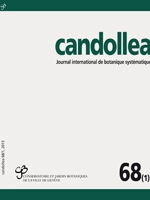Gregor, T., J.-M. Tison & L. Garraud (2013). Neotypification of Potentilla cinerea Vill. (Rosaceae). Candollea 68: 155–158. In English, English and French abstracts.
A neotype is chosen for the name Potentilla cinerea Vill. (Rosaceae) for which the nomenclatural history is given. The description of the taxon is also reported.
Introduction
Potentilla cinerea Vill. is the oldest name for the group of Potentilla L. with stellate hairs and was created by Villars (1779). The diagnosis is short: ”Potentilla foliis quinis obovatis molliter villosis, obtuse serratis ; caulibus prostratis. […] Affinis Potent, vernœce Linn.” Villars ascribed the name to Dominique Chaix (1730–1799). ”Pentaphyllum montanum minus luteo Tormentillœ flore cineraceum” from Barrelier (1714: 709) is cited as a possible synonym, probably because neither Barrelier's description nor the engraving is very informative. Later, Villars (1789: 566–567) renamed the species with the illegitimate name P. opaca Vill. (illegitimate because P. opaca L. in 1759), cited the engraving of Barrelier without a question mark, added a detailed description to his diagnosis from 1779. Most importantly, he informed the public about the only location: ”Elle vient sur des rochers à l'abri, et parmi des broussailles, sur une montagne des Baux proche Gap […]”.
The name P. cinerea is widely used for Potentilla taxa with stellate hairs: P. cinerea subsp. incana (G. Gaertn., B. Mey. & Scherb.) Ascii., P. cinerea subsp. velutina (Lehm.) Nyman, and P. cinerea subsp. tommasiniana (F. W. Schultz) Vel. This specific name was used for the whole complex in France (e.g. Coste, 1901; Fournier, 1940), Spain (e.g. Bolòs & Vigo, 1984; Guillén & Rico, 1998), Italy (e.g. Pignatti, 1982; Conti & al., 2005), and alpine countries (Aeschimann & al., 2004). Swiss authors, traditionally, use P. cinerea in a narrow sense (e.g. Binz & Thommen, 1966), but not always according to its typical populations described here (Lauber & Wagner, 2007), though the typical taxon does exist in this country. This species is restricted to the Southwest Alps in Switzerland, France, and Italy. The typification of P. cinerea will, hopefully, stabilize the use of the name.
No material related to P. cinerea could be found in Villar’s herbarium. Timbal-Lagrave (1856: 61) mentioned a specimen of”Potentilla opaca Vill. P. cinerea” in ”v. 4, fol. 15” of Chaix's herbarium which might belong to the original material. After Chaix's death in 1799, his main herbarium was bought by Philippe P. Lapeyrouse and came to Toulouse where it was studied by Timbal-Lagrave (1856). This herbarium is missing today.
Another small herbarium from Chaix ”Reliquae Chaixianae” is housed at GAP and includes two specimens named P. opaca without date (Fig. 1, bottom row, right):
a) the right plant (unfortunately bearing the label) belongs to a peculiar type of P. verna L. with spreading hairs on the petioles, which is common in the southwestern Alps including the locality of Rabou;
b) the left plant in contrast belongs to P. cinerea. We are unable to know if the latter specimen is an original material though the name P. opaca (subsequent to P. cinerea) suggests it is not. However, it is a suitable neotype. The plant is in good condition, representative of the taxon, and indirectly linked to the description by Chaix, thus as close to Villars’s concept as possible.
Potentilla cinerea Vill., Prosp. Hist. PL Dauphiné: 46. 1779.
≡ Potentilla opaca Vill., Hist. Pl. Dauphiné 3: 566. 1788 [nom. illeg.]
≡Potentilla verna subsp. cinerea (Vill.) Schübl. & G. Martens, Fl. Würtemberg: 341. 1834.
≡ Potentilla acaulis subsp. cinerea (Vill.) Soják in Preslia 65: 129. 1993.
Neotypus (here designated) : ”Potentilla opaca”, Reliquae Chaixianae, s.d., s.coll. (GAP [GAP002134], arrow) (Fig. 1).
Mat-forming perennial subshrub with rooting, mostly subterraneous creeping woody stems; ascending flowering stems up to 15 cm tall; leaves on both sides with a more or less continuous tomentum of stellate hairs, its density increases with light exposure. Stellate hairs with 10–20 short rays and sometimes a long central hair up to 0.5 mm long. Leaves rarely ternate, mostly 5-digitate; petioles with few-branched stellate hairs and simple hairs of about 0.3 mm length as well as patent hairs of 2–3 mm length, the latter being absent in related species, all hairs translucent; central leaflet 15-23 × 7-9 mm, oblong-obovate with a cuneate base, apically dentate from about the middle, teeth mostly blunt, grey-green above, grey beneath; stipules of basal leaves linear, about 1 cm long. Flowers 1–6, in cymes. Sepals ovate or ovate-lanceolate; epicalyx-segments lanceolate or elliptical, usually shorter than sepals. Petals 4–7 mm, light yellow to golden yellow, longer than sepals. Achenes rugose; style conical at base, slightly clavate at apex. Chromosome number 2n = 28.
Acknowledgements
We are very grateful to Vincent Poncet from the Musée d'Histoire Naturelle de la Ville de Grenoble (GRM) for easing access to Villars's herbarium and his private copies of Barrelier's works. Ralf Hand, Botanical garden and botanical museum Berlin, traced rare literature.






